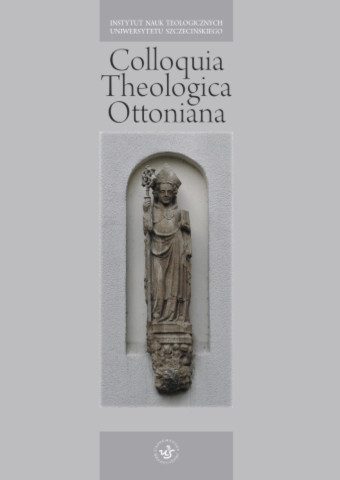
ISSN: 1731-0555
eISSN: 2353-2998
OAI
DOI: 10.18276/cto.2015.2-07




Lista wydań /
2/2015
Architektura w dziejach teologii
| Autorzy: |
Piotr
Liszka
Papieski Wydział Teologiczny we Wrocławiu |
| Słowa kluczowe: | architecture history understanding Middle Ages baroque building style |
| Data publikacji całości: | 2015 |
| Liczba stron: | 12 (163-174) |
Abstrakt
Architecture has always been a means of expressing world viewpoints that are governing in a given society. Gothic architecture expressed man’s desire to come closer to divine infinity. Gothic cathedrals would combine two worlds separated by an infinite metaphysical distance. Baroque architecture attempted to include in the vertical scheme the whole heritage of the passing and the temporal: aspects of nature, human existence and the richness of human spirituality. All this in a temporal, diachronic aspect, an aspect subjected to constant change, an aspect full of energy, dynamics and motion. The 20th century introduced trends that attempted to unite the visible world with the divine. Matter was divine and the divinity was material. This pantheistic interpretation of nature was reflected in architecture. Will Christian architecture come to an end or will it triumph? Will architecture be a stumblingblock or a spring-board for the Christian faith? This triumph will not be achieved by looking for new arguments in the never-ending debate, but through a better understanding of Christian Revelation, which is known but superficially, both by Christians and their adversaries. That is the reason why architecture contains and expresses merely a general outline of Christian doctrine. Ideas expressed in other architectural styles also have a superficial influence.
Pobierz plik
Plik artykułu
Bibliografia
| 1. | Białostocki J., Barok, W sztuce sakralnej, w: Encyklopedia katolicka, t. 2, red. F. Gryglewicz, R. Łukaszyk, Z. Sułowski, Lublin 1985, 45–50, kol. 50. |
| 2. | Capra F., Steindl-Rast D., Należeć do wszechświata. Poszukiwanie na pograniczu nauki i duchowości, Kraków 1995. |
| 3. | Drapella-Hermansdorfer A., Od autorki, w: A. Drapella-Hermansdorfer, Idea jedności w architekturze, Wrocław 1998. |
| 4. | Duby G., Czasy katedr, Warszawa 1986. |
| 5. | Eco U., Sztuka i piękno w Średniowieczu (wyd. oryg.: Arte e bellezza nell’ estetica medievale, Milano 1987), tłum. M. Olszewski, M. Zabłocka, Kraków 1997. |
| 6. | Fuentes C., Pogrzebane zwierciadło, tłum. E. Klekot, Łódź 1994. |
| 7. | Giedion S., Przestrzeń, czas, architektura. Narodziny nowej tradycji, Warszawa 1968. Gonzáles de Cardedal O., La entrańa del cristianismo, wyd. 2, Salamanca 1998. |
| 8. | Hani J., Symbolika świątyni chrześcijańskiej, Kraków 1998. |
| 9. | Hryniewicz W., Staroruska teologia paschalna w świetle pism św. Cyryla Turowskiego, Warszawa 1993. |
| 10. | Ivanov M.S., K probleme bogoslovskogonasledija Drevnej Rusi (XI – načalo XIII veka), „Bogoslovskie Trudy” 29 (1898), s. 24. |
| 11. | Kałużny J.C., Kształtowanie się przedstawień chrystologicznych jako świadectwo ideowych przemian w Kościele III i IV wieku, „Studia Laurentiana” 4 (2002) [Kraków 2004], s. 12. |
| 12. | Kiereś H., Klasyczna teoria sztuki, w: T. Rakowski (red.), U źródeł tożsamości kultury europejskiej, Lublin 1994, s. 201–218. |
| 13. | Kiwka M., Rozumieć filozofię, Wrocław 2007. |
| 14. | Klauza K., Hermeneutyczna wartość symbolu ikonograficznego, RTK 2 (2002), s. 101–109. Markowski M.P., Northrop Frye: literatura jako objawienie, w: N. Frye, Wielki kod. Biblia i literatura (wyd. oryg.: The great code. The Bible and literature, Harcourt Brace & Company 1981), tłum. A. Faulińska, Bydgoszcz 1998, s. 7–23. |
| 15. | Mikołajczak B., Analogia III. W teologii, A. Dzieje, w: Encyklopedia katolicka, t. 1, Lublin 1989, kol. 498–504. |
| 16. | Simson O. von, Katedra gotycka, Warszawa 1989. Paprocki H., Ikonostas, w: Encyklopedia katolicka, t. 7, red. S. Wielgus, Lublin 1997, kol. 18–20. |
| 17. | Pawlica M., Obecność sacrum w architekturze sakralnej – na przykładzie katedry gotyckiej, [praca mgr.] PWT, Wrocław 2001. |
| 18. | Redpath P.A., Odyseja mądrości. Od filozofii do transcendentalnej sofistyki (wyd. oryg.: Wisdom’s Odyssey. From Philosophy to Transcendental Sophistry, Amsterdam–Atlanta 1997), Lublin 2003. |
| 19. | Sebastian S., El grabado como vehículo difusor de los programas iconográficos en el arte colonial del México del siglo XVI. Actas del VII simposio de teología histórica (28–30 abril 1992), Valencia 1993, s. 35–43. |
| 20. | Wolicka E., Zamiast wprowadzenia, w: M. Kitowska-Łysiak, E. Wolicka (red.), Miejsce rzeczywiste. Miejsca wyobrażone. Studia nad kategorią miejsca w przestrzeni kultury, Lublin 1999, s. 5–15. |